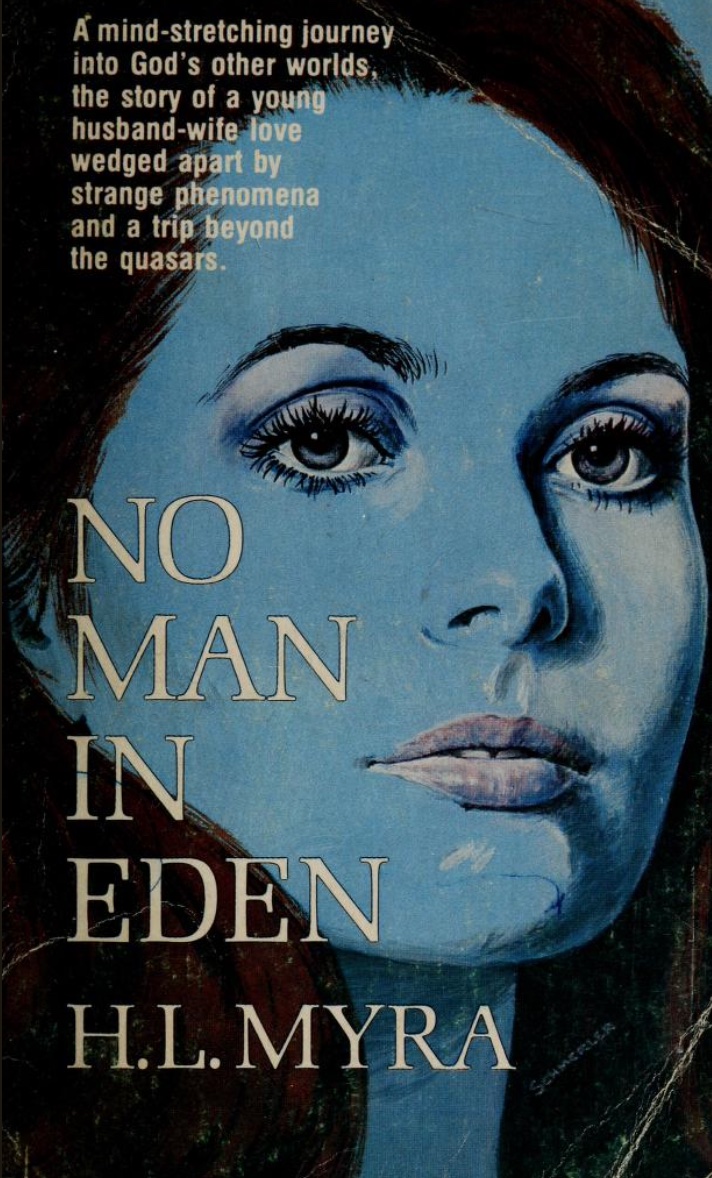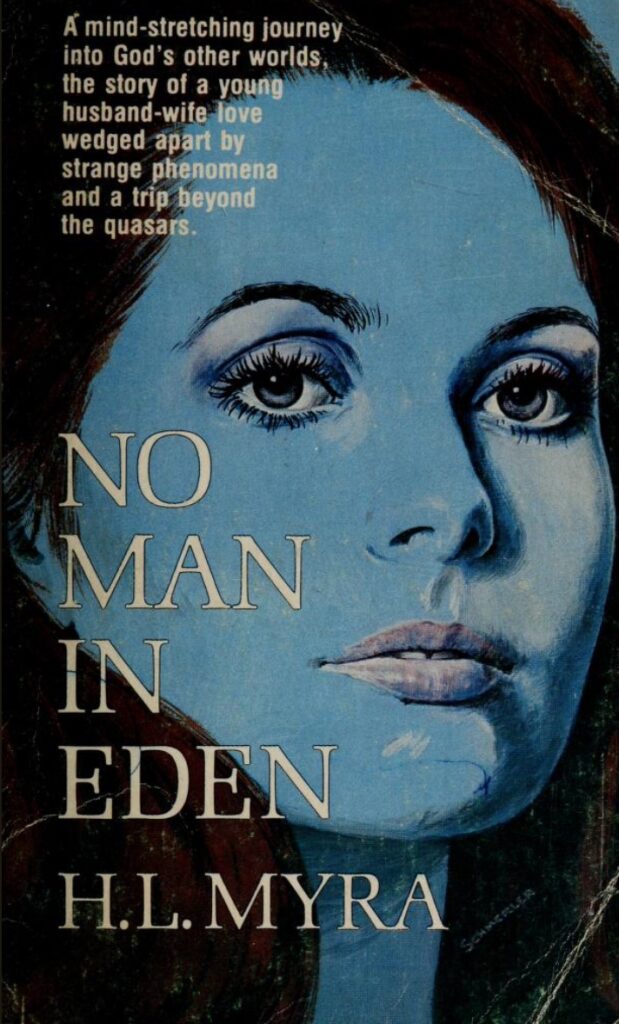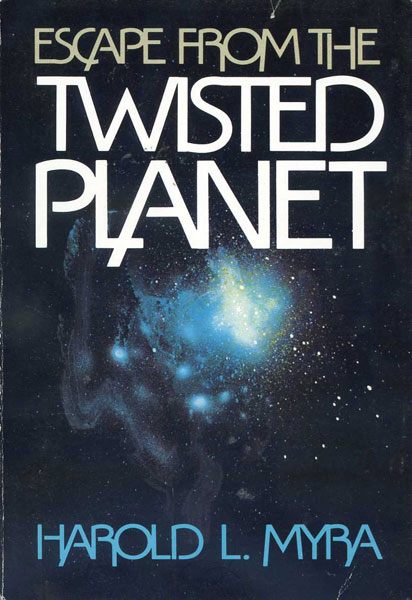I’ve been interested in finding more Christian science fiction from around the days of the Golden Age of sci-fi and after for a while now. As I’ve been reading some classic science fiction (and some not-so-classic . . . but old sci-fi), and as I’ve been revisiting Lewis’ Space Trilogy for the Strangers and Aliens podcast (listen to Out of the Silent Planet here and Perelandra here) I’ve wondered what other sci-fi from Christian authors was out there that was more contemporary to Lewis.
On a road trip while listening to Out of the Silent Planet, my mind wandered in that direction again. And not two days later, I was in a room at a conference center waiting for the people to come in who I was going to teach. There was a shelf of books they were giving away. Looking over the books to see if there was anything interesting I had missed last year when I was teaching at this same conference, I found a book called NO MAN IN EDEN. Was this theological treatise on original sin and the Genesis account? Was it a romance novel?
With no dust jacket and therefore no book description, I flipped it open and found this on the copyright page: “The author acknowledges his debt to many writers and speakers, among them C.S. Lewis, J.R.R. Tolkien, Ray Bradbury, Malcolm Cronk and Jay Kessler.” I have no idea who Malcolm Cronk is. Jay Kessler I am familiar with because of his involvement in higher education here in Indiana. Lewis and Tolkien would not surprise me in any book on Christianity. But Ray Bradbury?
Reading further, I saw the introduction by the author, entitled “Beyond Space Opera”. Now this book had my attention. What was I holding in my hands?
it turns out that while it was not quite contemporary with C.S. Lewis (the book was published in 1969), and not close to the Golden Age of sci-fi, it was a sci-fi novel from the heyday of UFOs. From the era of the New Wave of science fiction.
H.L (Howard) Myra’s novel absolutely owes a debt to C.S. Lewis, Bradbury, and Tolkien. (Myra’s debt t0 Cronk and Kessler I’m less certain of.) This book reads like someone just finished his Space Trilogy and then said, “I want to do that. Almost exactly that.” It’s the story of a music journalist who gets abducted by an alien from an unfallen world, who then visits a galaxy of unfallen worlds and on returning to Earth experiences a taste of Hell, too. All the while, he is dealing with a new marriage and a corporation that’s doing evil things.
It really is part Out of the Silent Planet, part Perelandra, and part That Hideous Strength. From the opening chapters detailing the mundane married life of two newlyweds (shades of That Hideous Strength) to the man being taken to another world against his will (Out of the Silent Planet) while an evil man comes along and brings Earth’s death and destruction with him while visiting a pure and unsinful planet (Perelandra) to an explosive riot around a big evil corporation (back to That Hideous Strength), it feels like Myra crammed the entire Space Trilogy into one book! Add in the metaphorical Hell that does not copy The Great Divorce but does feel like it’s cut from the same cloth. I’m glad Myra acknowledged his debt.
(Adding to the similarities, someone decided to change the title when reprinting the book in the 80s. The new title: Escape from the Twisted Planet, which is remarkably similar to Out of the Silent Planet and which would easily fit into a series of books that include Out of the Silent Planet and The Tortured Planet, the title for the abridged version of That Hideous Strength.)
Granted, there’s nothing new under the sun. All of this can be forgiven because while No Man in Eden is inspired by and an homage to these other things, it is not plagiarism. And, too, the debt to Bradbury that I picked up on, can also be forgiven. His aliens feel very much like the Martians from The Martian Chronicles. Especially their telepathy. Again, there’s nothing new under the sun. If he had not said anything, I probably wouldn’t have been looking for similarities. To Bradbury, at least. The Lewis similarities would have become obvious once the alien revealed to the main character his unfallen nature.
No Man in Eden is also very much cut from the cloth of the sixties. UFO abduction and alien contact is front and center. It feels odd, but it fits. The influence of rock and roll plays a big part in the plot. Race relations from the Civil Rights Movement are used to explore the most heinous of humanity’s modern sinfulness along with references to military action around the globe. And, most jarring of all, outdated (and offensive) racial terminology is used.
Myra does not just use this sci-fi book to make social commentary. He also dives into sci-fi ideas that Lewis never touched. He describes alien technology that would not feel too marvelous today, but back then would’ve been very forward thinking, particularly powerful and small computers and 3D immersive technology. He plays with the consequences of faster than light travel, not in the sense of relativity but in describing what it would be like to outrun the light from the star you are leaving behind you. The faster their ship leaves earth’s solar system, the older the light that would be visible at your new location. It was an idea that was new to me, anyway.
And then he plays with theological ideas as well. There’s the description of the utopia of an unfallen world. The “Eden” of the title. A stand out passage to me was when the aliens of that world speak of creating because God is a creative God, but Satan cannot create. The idea of Satan only being able to copy, not create, is one I have seen in Christian exploration of UFO experiences before – the idea being that fallen angels are the aliens, and when they experiment and probe and artificially inseminate it is to be like God.
Myra’s views of Christianity are Biblical, but some of the descriptions from the main character’s perspective as a recent convert come across with a little bit of a hippy-fish bent. In one scene, he says to someone that a spaceman had come to earth and been killed, and that spaceman was Jesus.
Possibly the most interesting concept that he uses is when he blends the science fiction with the theological ideas. The visiting alien explains to the main character that our universe is anti-matter and the rest of the universe is matter.
“Everything outside antimatter–that is, everything in matter–is ruled by the creatures of Aelor. We are privileged to share in his creativity by filling it with living beings and taming uncharted regions–and in our ever expanding universe, never will we come to an end of finding new worlds to conquer, new worlds to fill with people linked to Aelor and ruled by beings made by him.
No Man in Eden, pp. 83-84
“On the other hand, it seems to me that the Enemy and all those who follow him are, by their very nature, so corrupted that they eventually will not want the company of any other. The selfishnesses drive them apart, for they are only good to one another as objects of exploitation. If one has no power over the other, he’ll seek aloneness, and all the lists and appetites they have will go unassuaged in their loneliness.
“If there are one hundred billion stars–or ‘suns’–in anti-matter, this means there will be more than enough celestial bodies for each damned being to have his one private hell.”
David looked at him sharply. “You mean each one in a flaming sun thousands of degrees? Hell can’t be that literal, can it?”
“Oh,” Pelu said, “I have no idea. There would be planets around many of the suns, of course. Who knows–I’m simply pointing out there’s plenty of room in antimatter. Maybe, on the other hand, hell will be a small, compact place where evil spirits can taunt and torment each other, whether physically or mentally or emotionally or both.”
Myra goes on to have the characters speculate about how the fallen earth is in a different dimension than the unfallen universe, and gives spiritual descriptions to scientific (or science fictional) ideas.
I’m glad to have found this book and glad to have read it. I do not, however, recommend every Christian go out and find a copy and read it. I would categorize it as “sci-fi homework.” Read it if you want a broader view of Christians writing science fiction, especially in the middle of the New Wave with UFO’s in the popular consciousness. But it’s dated language (specifically it’s racial language, which is not a heavy presence but is present) would cause me to only give a cautious recommendation. Also, while I had fun reading it, the different sections felt disconnected from each other and the abrupt disposal of characters and introductions of other characters could be jarring.
But to find this book mere days after speculating about books like this, especially on a shelf of free books I have looked over multiple times last summer and a time or two this summer (and passing over this book every time!), was pure serendipity. I had skipped over the book because without its book cover, it looked like a romance novel. (Actually, the picture on the dust jacket would not have changed that . . . except for the cover copy: “A Mind-Stretching Journey into God’s other Worlds, The Story of a Young Husband-Wife Love Wedged Apart By Strange Phenomena and a Trip Beyond the Quasars”. Good grief! That would’ve grabbed me immediately!)
I’m glad I discovered it, but I can only mildly recommend it. As much as Myra was looking backward toward Lewis’ Space Trilogy and Bradbury’s Martian Chronicles and Bunyan’s allegories, he was also blazing a trail in a few ways. First, in his theological exploration of scientific ideas; then, in his explanation of the building UFO craze. He’s not the last Christian author to give a spiritual twist to UFOs and alien abduction, but it seems like he may have been one of the first. For that reason, I’d consider this book a must read in an archeological sense, for the person wanting to uncover roots of Christian science fiction.



Leave a Reply